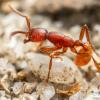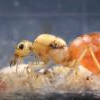Colony update: The colony is moving along. I am working on getting them winterized, so the colony is still in basement, unheated and exposed to the cooling temperatures. I have provided piles of dry leaves and other layered areas for the colony to take shelter in as the weather cools more and I am hopeful it will go into a dormant/reduced activity phase for the winter. The colony is active still, though much slower in over all movements. The colony has surpassed all expectations on its durability and actual ease at being kept.
- Formiculture.com
- Forums
- Gallery
- Members
- Member Map
- Chat
















